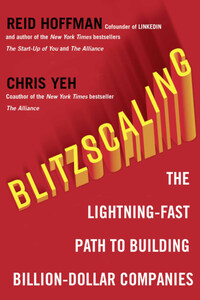HarperCollinsPublishers
1 London Bridge Street
London SE1 9GF
www.harpercollins.co.uk
First published in the US by Currency, an imprint of the Crown Publishing Group, a division of Penguin Random House LLC, New York
This UK edition published by HarperCollinsPublishers 2018
FIRST EDITION
© Reid Hoffman and Chris Yeh 2018
Cover layout design © HarperCollinsPublishers Ltd 2018
A catalogue record of this book is available from the British Library
Reid Hoffman and Chris Yeh assert the moral right to be identified as the authors of this work
All rights reserved under International and Pan-American Copyright Conventions. By payment of the required fees, you have been granted the nonexclusive, non-transferable right to access and read the text of this e-book on screen. No part of this text may be reproduced, transmitted, downloaded, decompiled, reverse engineered, or stored in or introduced into any information storage retrieval system, in any form or by any means, whether electronic or mechanical, now known or hereinafter invented, without the express written permission of HarperCollins e-books.
Find out about HarperCollins and the environment at www.harpercollins.co.uk/green
Source ISBN: 9780008303631
Ebook Edition © October 2018 ISBN: 9780008303655
Version 2018-09-10
I’ve known Reid Hoffman for years. Our friendship started on my visits to Silicon Valley to meet with Greylock Partners, the venture capital firm where Reid is a partner, so I could learn about the companies they were investing in. I was always impressed by his sharp mind and brilliant business sense. Reid is famous for hosting long dinners where the conversation runs late into the night, and we’ve spent many meals breaking down the technology industry, analyzing the promise of artificial intelligence, and more. When Microsoft CEO Satya Nadella started talking about acquiring LinkedIn, I knew it would be an amazing fit.
Of all the things I’ve discussed with Reid, the most thought-provoking might be blitzscaling. It is an idea that applies to many different industries, as he and Chris explain in the last section of this book. But prioritizing speed over efficiency—even in the face of uncertainty—is especially important when your business model depends on having lots of members and getting feedback from them. If you get in early and start getting that feedback and your competitors don’t, then you’re on the path to success. In any business where scale really matters, getting in early and doing it fast can make the difference.
This is especially true for two-sided business models, where you have two user groups that create positive network effects for each other. For example, LinkedIn wants to attract people who are looking for work as well as employers who want to hire them. Airbnb wants guests looking for a place to stay as well as hosts with space to rent. Uber wants to attract drivers as well as riders.
And a software company with an operating system to sell wants app developers as well as end users. Microsoft definitely went through a blitzscaling phase (although we didn’t call it that at the time). We got on the learning curve early and were able to build a reputation as a serious company. We had an extreme culture of working hard and getting things done fast.
The ideas behind blitzscaling aren’t just for startups and scale-ups. They’re important for big, established companies too. The window for action can be tiny and it can close quickly. Even a few months of hesitation can mean the difference between leading and chasing.








